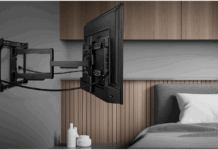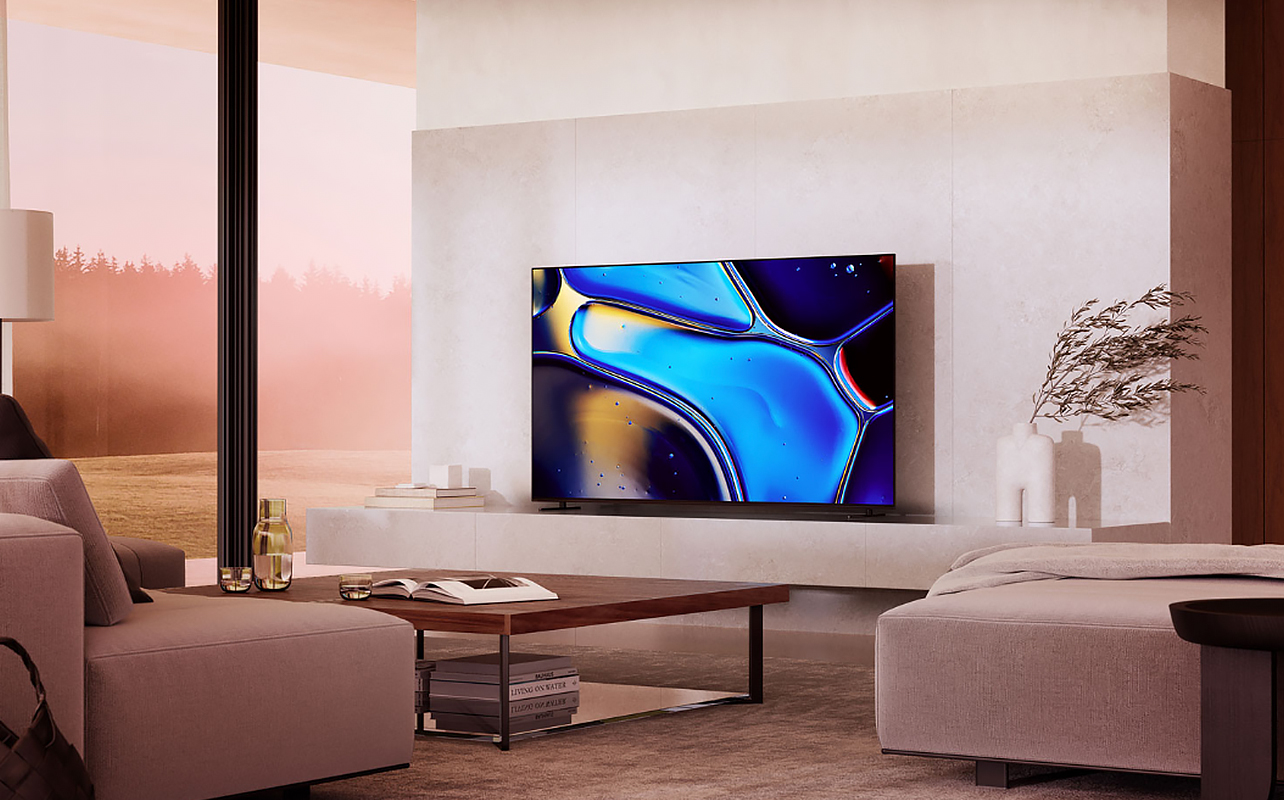
OLED vs QLED? QNED vs mini-LED? What do these acronyms mean and which one do you need? Understanding these display types can help you choose the right TV for your home. These different screen technologies power the visuals you see and shape your overall viewing experience. Each one has its own strengths—from producing velvety black levels for moody dramas to staying clear and punchy under midday sunlight. Knowing the difference helps you avoid overpaying for features you’ll never use—or worse, missing out on tech that would take your movie nights, game days, or binge sessions to the next level.
In this guide, we’ll decode the tech jargon, break down the six major types of TVs, and help you find the screen that suits your real-life habits—not just the spec sheet.
The 6 different TV display types
Want deep blacks for movie nights? Bright colours for watching sports during the day? There’s a TV display type for that.
1. OLED TVs
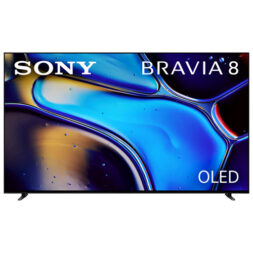
Organic Light-Emitting Diode or OLED TVs are a favourite among movie-lovers who love deep contrast and cinematic quality. Each pixel lights up on its own, so you get vibrant colours and true blacks (not just dark greys). Unlike other TVs that rely on a backlight, OLED panels use organic compounds that emit light when electricity is applied. This means each pixel acts as its own light source and can turn on or off independently—you get the perfect black levels and incredible contrast.
OLED TVs also offer ultra-wide viewing angles—meaning the picture stays consistent even if you’re sitting off to the side of the screen. Unlike some backlit TVs that lose brightness or colour accuracy when viewed from an angle, OLED keeps everything crisp and vivid from almost any seat on the couch. So whether you’re hosting a movie night or just sprawled out at an awkward angle, everyone gets the same jaw-dropping visuals.
Choose an OLED TV for a cinematic experience. Place it in a room with controlled lighting. Dim the lights and watch as your favourite films transport you into every scene. Stream moody dramas or sci-fi epics without glare or washed-out details. For cinephiles and serious streamers, OLED delivers the kind of image precision that makes popcorn nights feel like a private screening. Just keep in mind that static images left onscreen too long can still cause image retention (burn-in), although newer models have excellent tech to manage this.
How does OLED TV stack with LED TV? Learn about the difference between OLED and LED TVs and which TV screen type suits you.
2. QLED TVs
Designed to shine (literally) in bright environments, QLED TVs (Quantum Dot LED) uses Quantum Dots to supercharge brightness and colour. So everything from animated films to documentaries feel more lifelike and punchy. What exactly are quantum dots? They’re microscopic semiconductor particles that emit extremely precise colours when hit by light. In QLED TVs, a backlight shines through a quantum dot layer, which then produces vibrant reds, greens, and blues, resulting in brilliant colour accuracy. In other words, QLED improves picture quality by turning light into bright, accurate colours—no matter the lighting conditions.
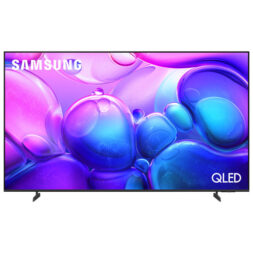
Set up a QLED TV in your brightest room. Stream live sports and watch every blade of grass on the field pop, even with the sun pouring in. While it doesn’t offer the same pitch-black shadows as OLED (since QLED still relies on a backlight), it gives you vivid colour reproduction and screen clarity. That’s why QLEDs are a fantastic choice for bright living rooms and open-concept spaces so you can watch a lot of daytime TV or live sports even when the sun’s streaming through the window.
Compare QLED TVs with other TV display types. Read more on the difference between QLED vs LED TVs or QLED vs mini-LED.
3. QNED TVs
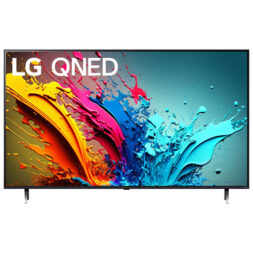
QNED is a fusion of Quantum Dot and NanoCell technology—a colourful tag team for high-impact visuals. These TVs offer better brightness and a wider colour spectrum than standard LED TVs, plus improved contrast and local dimming. The result? A punchy, vibrant screen that doesn’t get washed out in a well-lit room.
Combined with Quantum Dot, NanoCell tech adds another layer of colour refinement using nanoparticles to filter out dull colours and enhance colour accuracy. This combo gives QNED TVs the edge in delivering brilliant clarity. They really shine when showing animated series, blockbuster action movies, or any content where high energy and bold visuals take centre stage. Its vibrant colour accuracy and bright output bring animated characters and fast-paced scenes to life.
Install a QNED TV in a large, well-lit living room where your TV needs to be both bold and brilliant. Use QNED’s vibrant visuals to anchor the room, whether you’re entertaining guests or hosting a movie night. If your family loves eye-popping content and you want a screen that thrives in big, bright spaces, QNED is a colourful crowd-pleaser.
Torn between QNED TV or OLED TV? Discover their key differences and drawback to find the perfect display type for you.
4. Mini-LED TVs
Mini-LED is a newer type of display that improves on traditional LED/LCD TVs by shrinking the backlight LEDs. This allows for more precise dimming, deeper contrast, and better overall brightness. So why does size matter? By using thousands of miniaturized LEDs in the backlight, mini-LED TVs can better control light zones. This results in more targeted dimming and less light bleed, enhancing contrast and reducing the halo around bright objects on dark backgrounds.

Mini-LED TVs are a solid pick for households with varied viewing needs. Whether you’re catching the latest HDR movie, watching a hockey game in broad daylight, or streaming high-res YouTube content with rich lighting effects, this type of screen adjusts beautifully to any situation. Great for shared spaces with mixed lighting or shared viewing interests, mini-LED TVs are amazing in bright rooms and also in dark home theatres.
Place this versatile display in any room where lighting conditions and viewing preferences vary. Take advantage of its superior brightness, impressive contrast, and precise local dimming to enjoy a balanced viewing experience. Love HDR content? Then make this your go-to, as mini-LED TVs excel at delivering the rich detail and dynamic range that HDR demands.
From deep blacks to dazzling highlights, find out whether the mini-LED or OLED is right for you.
5. LED/LCD TVs
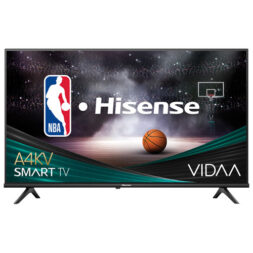
LED TVs are the most common and most affordable display type on the market. Technically, they’re LED-backlit LCD screens, and you’ll usually find them as either edge-lit (light around the frame) or full-array (even backlight across the whole screen). Edge-lit models use LEDs positioned along the edges of the screen, which often lead to uneven brightness in darker scenes. Full-array models, on the other hand, use a grid of LEDs across the entire back panel. This allows for better brightness uniformity and contrast, especially when combined with local dimming features. LED TVs don’t hit the same highs in contrast or colour depth as OLED or QLED, but they do just fine for general viewing.
Looking for a reliable, no-fuss screen? Choose an LED/LCD TV for your bedroom, kitchen, dorm room, or as a secondary setup. Stick to the essentials—watch the news, flip through sitcoms, or let YouTube run in the background while you cook. Enjoy decent quality without breaking the bank.
6. MicroLED TVs: the future of TV display?
MicroLED is the cutting-edge tech that has home theatre connoisseurs super excited. Like OLED, each pixel is self-lit, giving it unmatched contrast and precision. But unlike OLED, MicroLED is much more resistant to burn-in and can reach even higher brightness levels. Why is it burn-in resistant? Because MicroLEDs use inorganic materials that don’t degrade over time with static images, unlike the organic compounds in OLEDs. This makes them a safer pick for users who leave the screen on for long periods—think digital art displays or 24/7 dashboard viewing.
Right now, MicroLED TVs like Samsung The Wall are mainly for early adopters and folks with a generous home theatre budget. But the viewing experience is second to none—ideal for large-format content like 8K movies, prestige streaming releases, or showcasing your 4K Blu-ray collection at its absolute best. Bonus: these TVs are modular, meaning you can literally build a custom-sized screen wall with near-perfect clarity.

If you’ve got the budget and the wall space, go all in with a MicroLED TV. Install it in a custom media room or showcase it as a centrepiece in your living space. Expect pixel-perfect contrast, ultra-high brightness, and modular options that let you build a truly massive screen. Stream 8K movies and prestige content with confidence, knowing you’re getting one of the most advanced displays available.
Television display types: which one is right for you?
Here’s a quick cheat sheet to help you compare TV screen types:
| Display type | Pros | Best for | Typical price range |
|---|---|---|---|
| OLED | Perfect blacks, high contrast, ultra-wide viewing angles | Dark rooms, cinematic viewing, high-end gaming | $1,300–$5,000+ |
| QLED | Exceptionally bright, vivid colours, great daytime performance | Bright rooms, sports, family viewing | $800–$3,000 |
| QNED | Boosted brightness and colour accuracy, local dimming | High-energy content, large family rooms, 4K fans | $1,000–$3,500 |
| Mini-LED | Enhanced backlight control, high brightness and HDR support | Mixed lighting environments, HDR content | $1,000–$3,200 |
| LED/LCD | Affordable, widely available, dependable for basic needs | General TV viewing, secondary screens, small spaces | $250–$1,500 |
| MicroLED | Top-tier contrast and brightness, modular, burn-in resistant | Prestige setups, premium home theatres | $30,000+ |
The best display type ultimately comes down to how you watch TV. Use this table as a starting point, but don’t forget to factor in your room’s lighting, layout, and what kind of content you love most. Matching the tech to your lifestyle is the key to getting a screen you’ll truly enjoy.
Choose the TV screen type that suits you

Understanding the different television types helps you choose based on your needs, not just flashy features. Pick the right one that suits your viewing habits and space. Love the cinematic experience right at home? With perfect black and vibrant colours, OLED might be your best friend. Want bold colour and brightness for a big, lively living room? QNED delivers eye-popping visuals that thrive in bright, social spaces. Hosting afternoon hockey watch party? Go QLED or mini-LED to showcase your bright, dynamic content. Budget-conscious but still want solid quality? LED still delivers. Choose the screen type that complements your experience.
Ready to upgrade? Discover a wide selection of TVs at Best Buy Canada.
This article was drafted using AI technology and then reviewed, fact-checked, and revised by a member of our editorial team.



